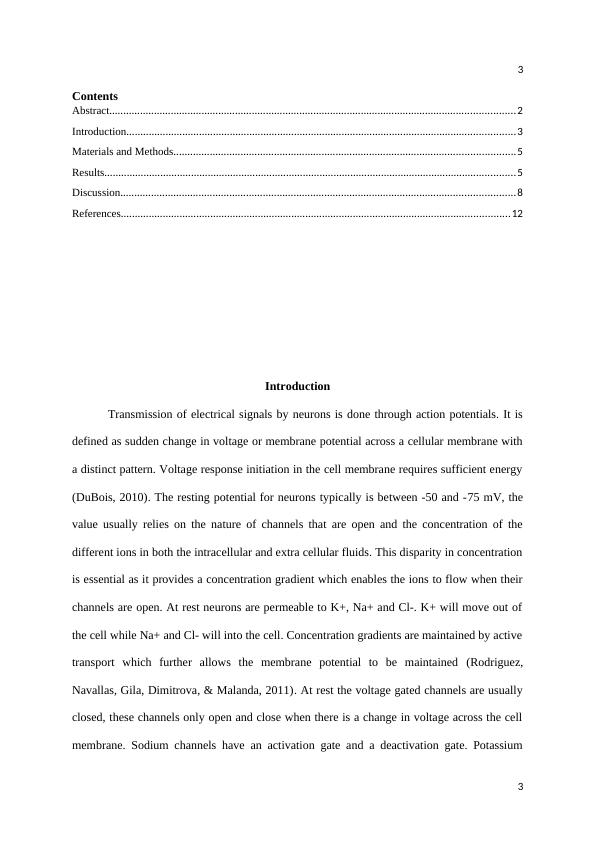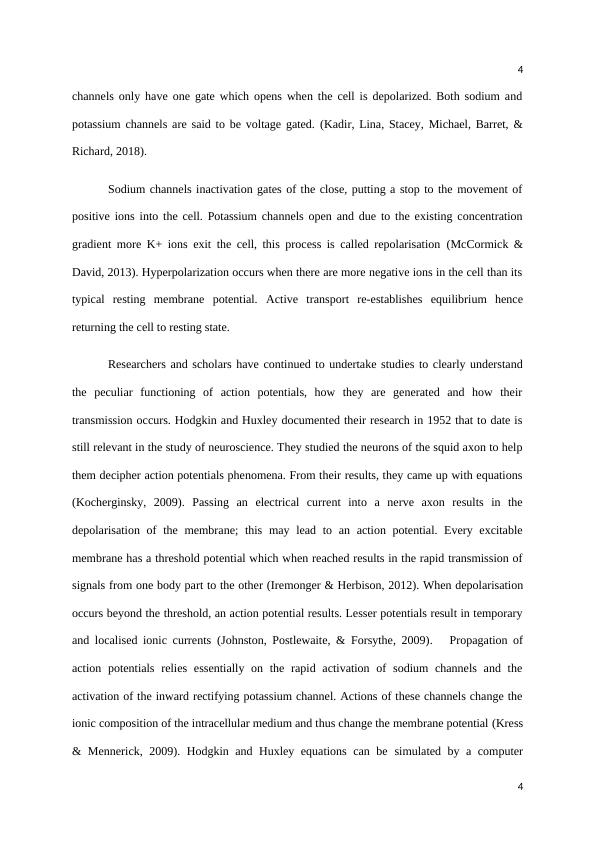Computer Simulation of Action Potentials in a Squid Axon
Added on 2023-04-20
13 Pages2349 Words345 Views
1
HPP2: COMPUTER SIMULATION OF ACTION POTENTIALS IN A SQUID AXON
Student Number (SRN): 17038533
Student Name:
Level 4 Human Physiology and Pharmacology 2018 4LMS0002
HPP2: COMPUTER SIMULATION OF ACTION POTENTIALS IN A SQUID AXON
Student Number (SRN): 17038533
Student Name:
Level 4 Human Physiology and Pharmacology 2018 4LMS0002

2
Abstract
This experiment was undertaken in order to simulate the generation of action
potentials. A computerised application simulated equations derived by Hodgkin and Huxley.
Results obtained were used to explain reactions that take place when electrical stimulation
occurs in the nerves. The experiment generally achieved its objectives as process of action
potentials generation and propagation was widely explored. Various scenarios were
experimented altering the intensity and duration of stimulus to have a deeper understanding
of these parameters in the generation of action potentials. The experiments revealed all the
principles studied in class and widened our understanding of transmission of impulses.
2
Abstract
This experiment was undertaken in order to simulate the generation of action
potentials. A computerised application simulated equations derived by Hodgkin and Huxley.
Results obtained were used to explain reactions that take place when electrical stimulation
occurs in the nerves. The experiment generally achieved its objectives as process of action
potentials generation and propagation was widely explored. Various scenarios were
experimented altering the intensity and duration of stimulus to have a deeper understanding
of these parameters in the generation of action potentials. The experiments revealed all the
principles studied in class and widened our understanding of transmission of impulses.
2

3
Contents
Abstract.................................................................................................................................................2
Introduction...........................................................................................................................................3
Materials and Methods..........................................................................................................................5
Results...................................................................................................................................................5
Discussion.............................................................................................................................................8
References...........................................................................................................................................12
Introduction
Transmission of electrical signals by neurons is done through action potentials. It is
defined as sudden change in voltage or membrane potential across a cellular membrane with
a distinct pattern. Voltage response initiation in the cell membrane requires sufficient energy
(DuBois, 2010). The resting potential for neurons typically is between -50 and -75 mV, the
value usually relies on the nature of channels that are open and the concentration of the
different ions in both the intracellular and extra cellular fluids. This disparity in concentration
is essential as it provides a concentration gradient which enables the ions to flow when their
channels are open. At rest neurons are permeable to K+, Na+ and Cl-. K+ will move out of
the cell while Na+ and Cl- will into the cell. Concentration gradients are maintained by active
transport which further allows the membrane potential to be maintained (Rodriguez,
Navallas, Gila, Dimitrova, & Malanda, 2011). At rest the voltage gated channels are usually
closed, these channels only open and close when there is a change in voltage across the cell
membrane. Sodium channels have an activation gate and a deactivation gate. Potassium
3
Contents
Abstract.................................................................................................................................................2
Introduction...........................................................................................................................................3
Materials and Methods..........................................................................................................................5
Results...................................................................................................................................................5
Discussion.............................................................................................................................................8
References...........................................................................................................................................12
Introduction
Transmission of electrical signals by neurons is done through action potentials. It is
defined as sudden change in voltage or membrane potential across a cellular membrane with
a distinct pattern. Voltage response initiation in the cell membrane requires sufficient energy
(DuBois, 2010). The resting potential for neurons typically is between -50 and -75 mV, the
value usually relies on the nature of channels that are open and the concentration of the
different ions in both the intracellular and extra cellular fluids. This disparity in concentration
is essential as it provides a concentration gradient which enables the ions to flow when their
channels are open. At rest neurons are permeable to K+, Na+ and Cl-. K+ will move out of
the cell while Na+ and Cl- will into the cell. Concentration gradients are maintained by active
transport which further allows the membrane potential to be maintained (Rodriguez,
Navallas, Gila, Dimitrova, & Malanda, 2011). At rest the voltage gated channels are usually
closed, these channels only open and close when there is a change in voltage across the cell
membrane. Sodium channels have an activation gate and a deactivation gate. Potassium
3

4
channels only have one gate which opens when the cell is depolarized. Both sodium and
potassium channels are said to be voltage gated. (Kadir, Lina, Stacey, Michael, Barret, &
Richard, 2018).
Sodium channels inactivation gates of the close, putting a stop to the movement of
positive ions into the cell. Potassium channels open and due to the existing concentration
gradient more K+ ions exit the cell, this process is called repolarisation (McCormick &
David, 2013). Hyperpolarization occurs when there are more negative ions in the cell than its
typical resting membrane potential. Active transport re-establishes equilibrium hence
returning the cell to resting state.
Researchers and scholars have continued to undertake studies to clearly understand
the peculiar functioning of action potentials, how they are generated and how their
transmission occurs. Hodgkin and Huxley documented their research in 1952 that to date is
still relevant in the study of neuroscience. They studied the neurons of the squid axon to help
them decipher action potentials phenomena. From their results, they came up with equations
(Kocherginsky, 2009). Passing an electrical current into a nerve axon results in the
depolarisation of the membrane; this may lead to an action potential. Every excitable
membrane has a threshold potential which when reached results in the rapid transmission of
signals from one body part to the other (Iremonger & Herbison, 2012). When depolarisation
occurs beyond the threshold, an action potential results. Lesser potentials result in temporary
and localised ionic currents (Johnston, Postlewaite, & Forsythe, 2009). Propagation of
action potentials relies essentially on the rapid activation of sodium channels and the
activation of the inward rectifying potassium channel. Actions of these channels change the
ionic composition of the intracellular medium and thus change the membrane potential (Kress
& Mennerick, 2009). Hodgkin and Huxley equations can be simulated by a computer
4
channels only have one gate which opens when the cell is depolarized. Both sodium and
potassium channels are said to be voltage gated. (Kadir, Lina, Stacey, Michael, Barret, &
Richard, 2018).
Sodium channels inactivation gates of the close, putting a stop to the movement of
positive ions into the cell. Potassium channels open and due to the existing concentration
gradient more K+ ions exit the cell, this process is called repolarisation (McCormick &
David, 2013). Hyperpolarization occurs when there are more negative ions in the cell than its
typical resting membrane potential. Active transport re-establishes equilibrium hence
returning the cell to resting state.
Researchers and scholars have continued to undertake studies to clearly understand
the peculiar functioning of action potentials, how they are generated and how their
transmission occurs. Hodgkin and Huxley documented their research in 1952 that to date is
still relevant in the study of neuroscience. They studied the neurons of the squid axon to help
them decipher action potentials phenomena. From their results, they came up with equations
(Kocherginsky, 2009). Passing an electrical current into a nerve axon results in the
depolarisation of the membrane; this may lead to an action potential. Every excitable
membrane has a threshold potential which when reached results in the rapid transmission of
signals from one body part to the other (Iremonger & Herbison, 2012). When depolarisation
occurs beyond the threshold, an action potential results. Lesser potentials result in temporary
and localised ionic currents (Johnston, Postlewaite, & Forsythe, 2009). Propagation of
action potentials relies essentially on the rapid activation of sodium channels and the
activation of the inward rectifying potassium channel. Actions of these channels change the
ionic composition of the intracellular medium and thus change the membrane potential (Kress
& Mennerick, 2009). Hodgkin and Huxley equations can be simulated by a computer
4

End of preview
Want to access all the pages? Upload your documents or become a member.
Related Documents
LQ B388- Membrane Potential | Questions & Answerslg...
|8
|1156
|54
Active Neural Properties (Doc)lg...
|9
|1838
|248
Anatomy Assignment (Doc)lg...
|3
|423
|191
Cell biology Assignment PDFlg...
|4
|792
|110
Cognitive Psychology Potential Membranelg...
|5
|908
|18
NA + K +ATPASE Lab Reportlg...
|14
|2654
|410
